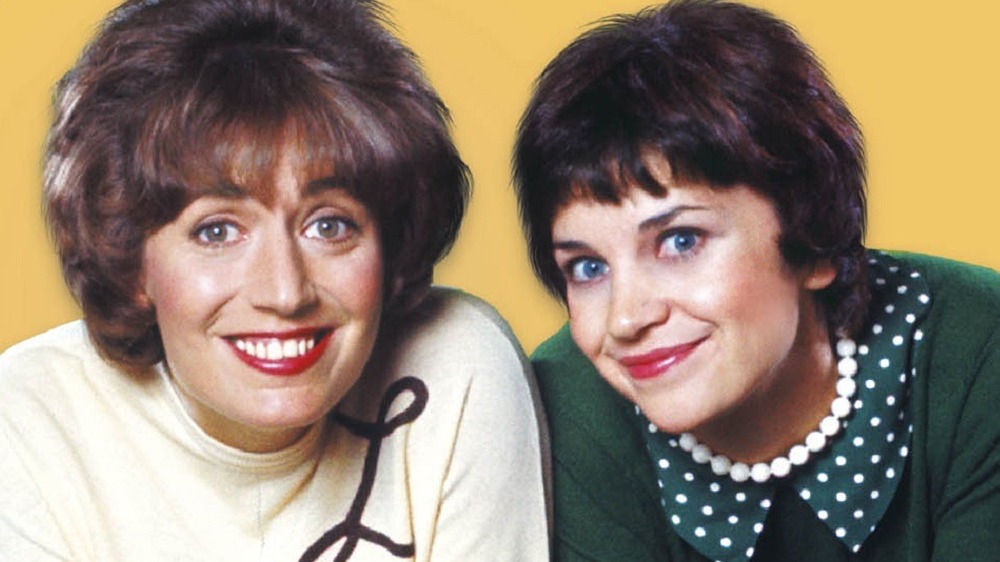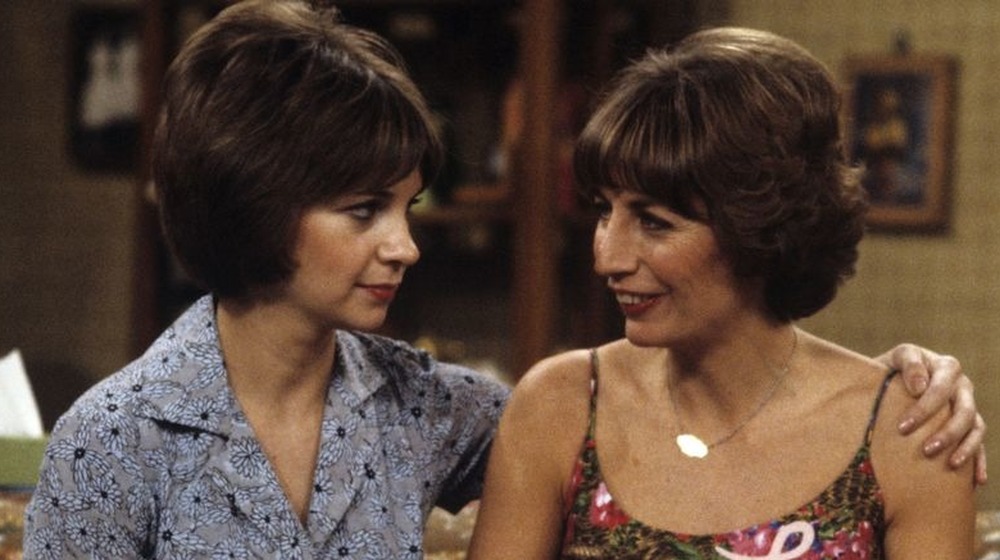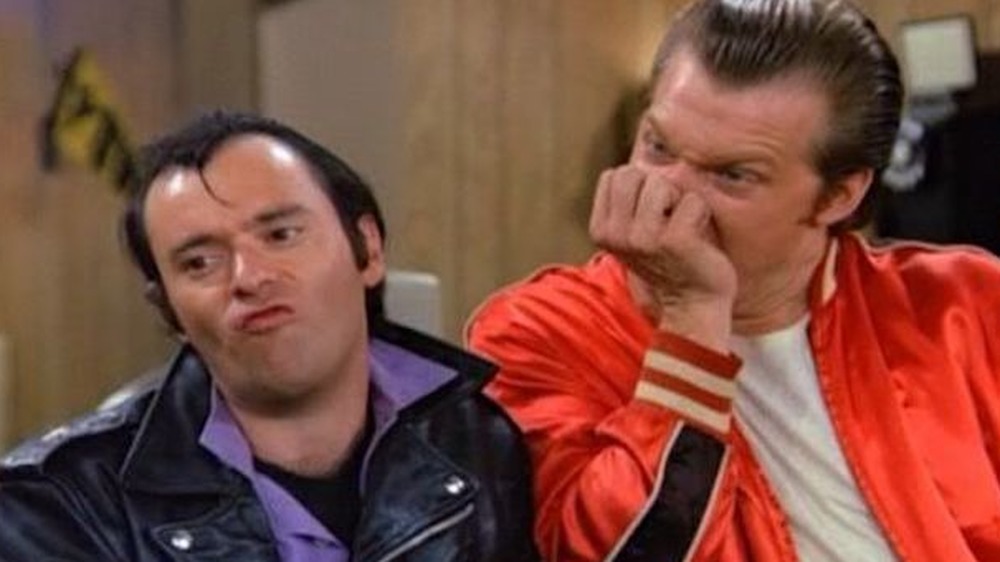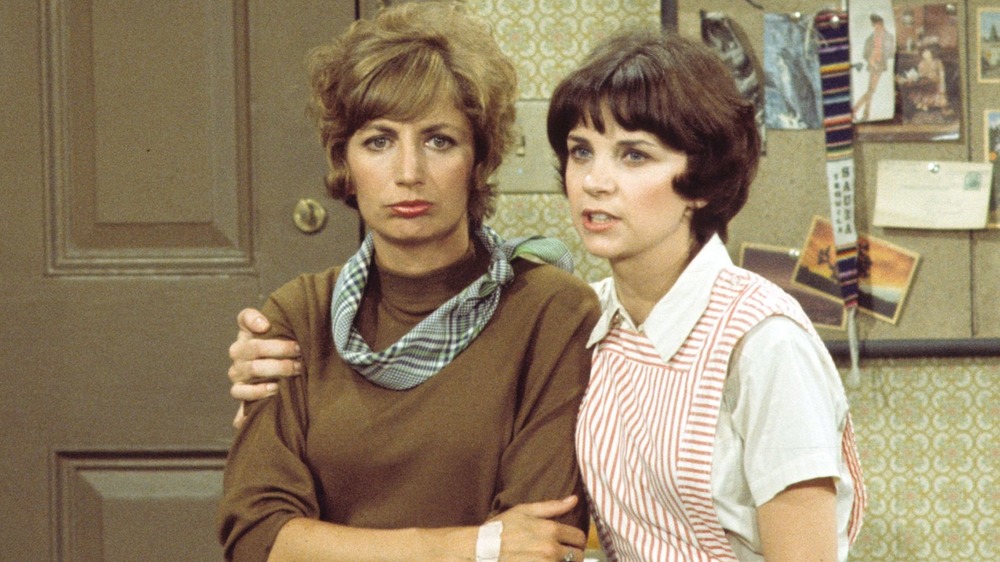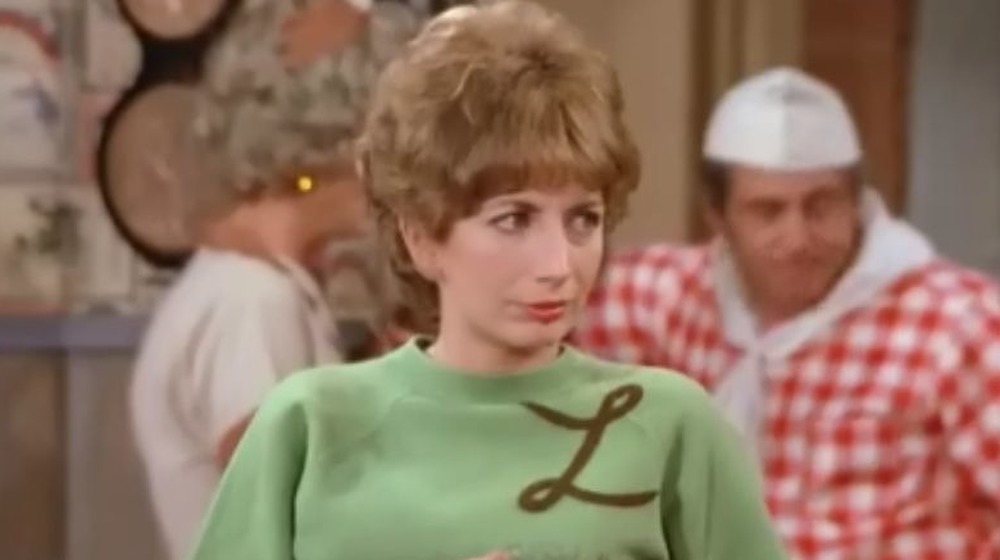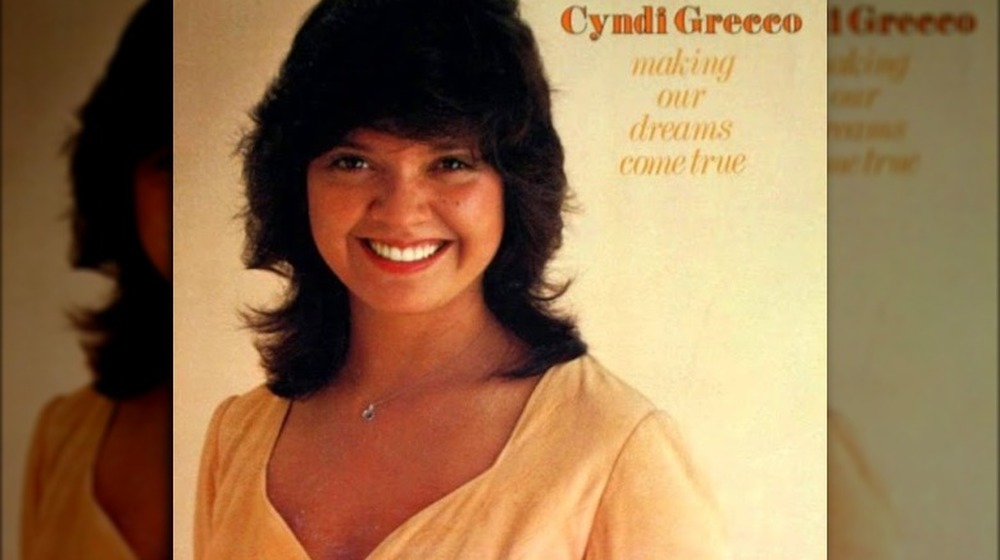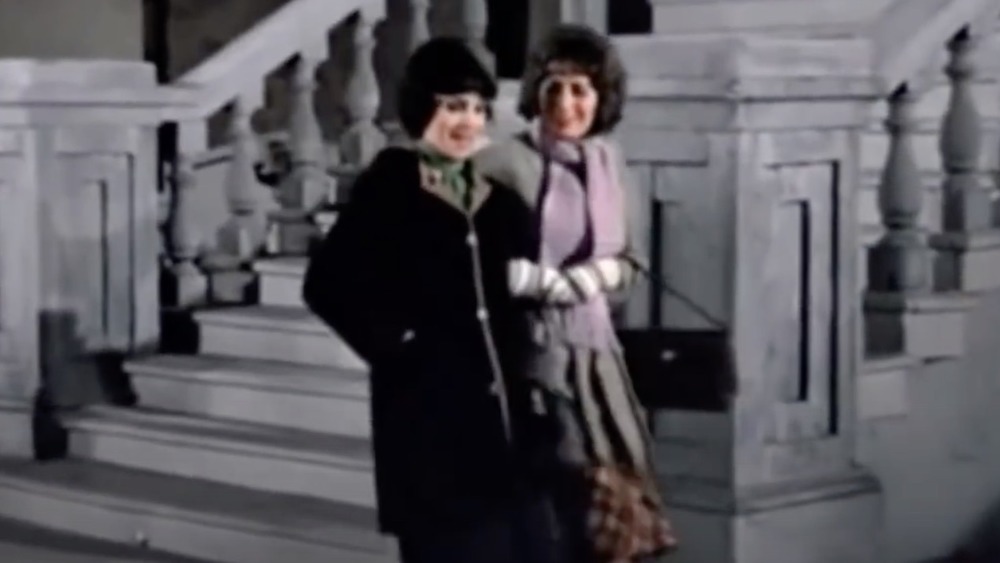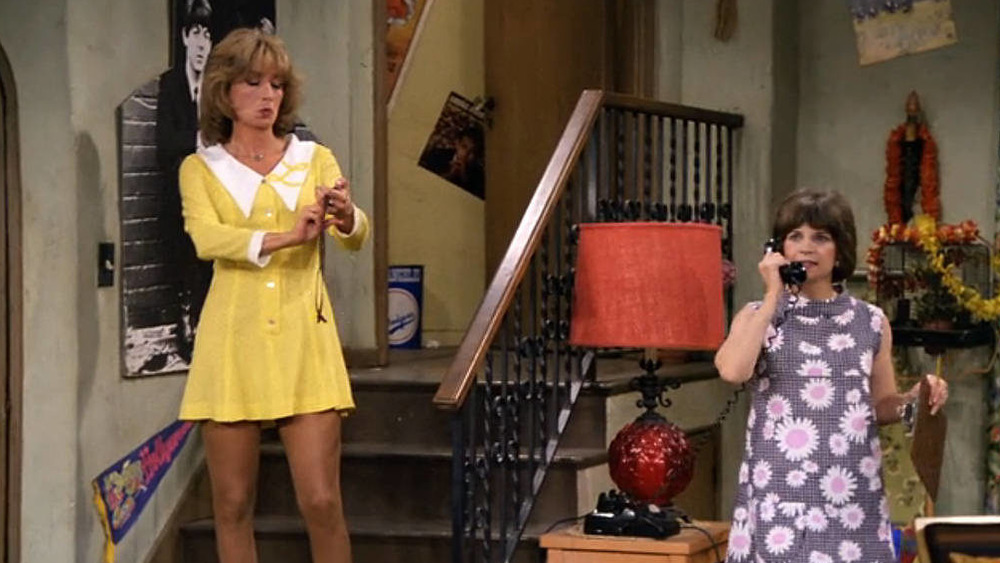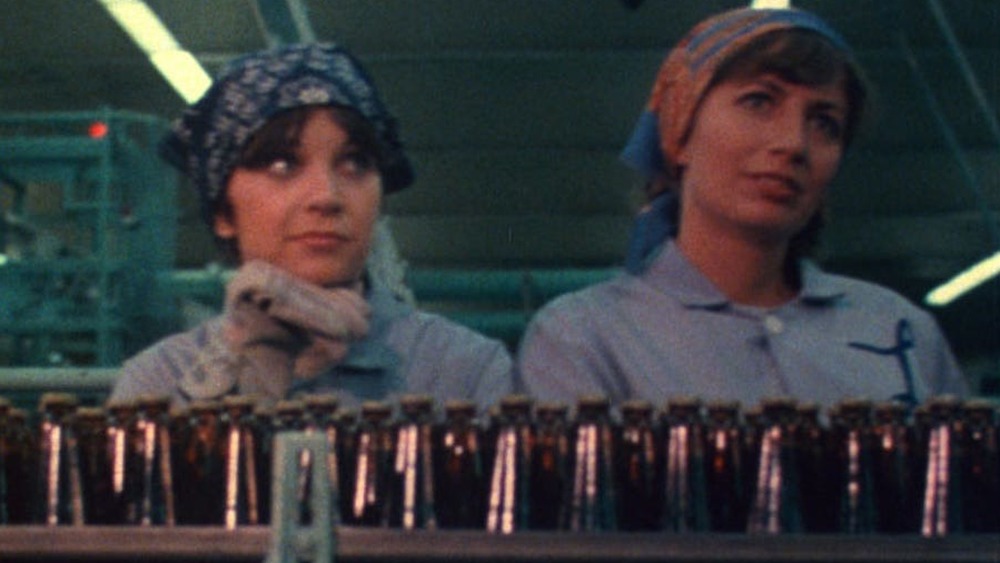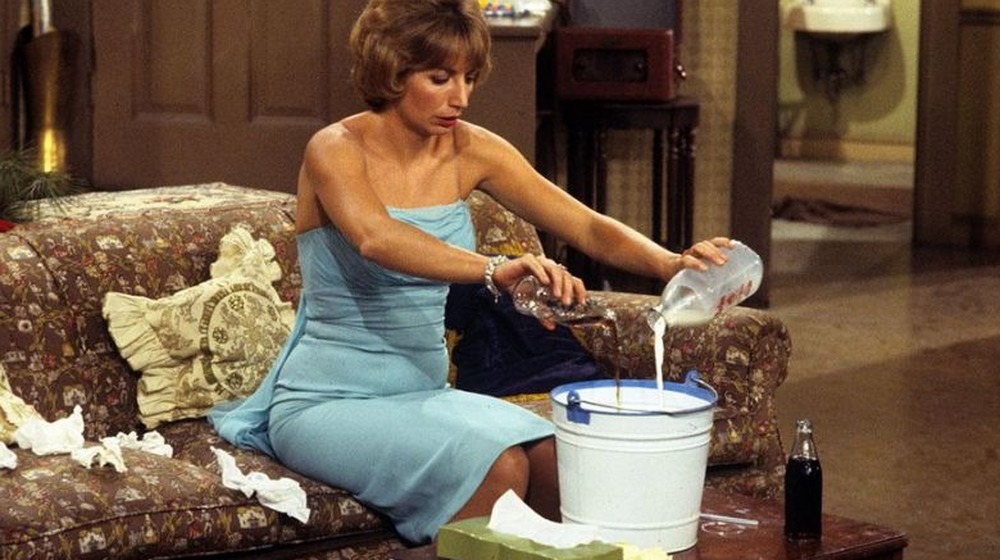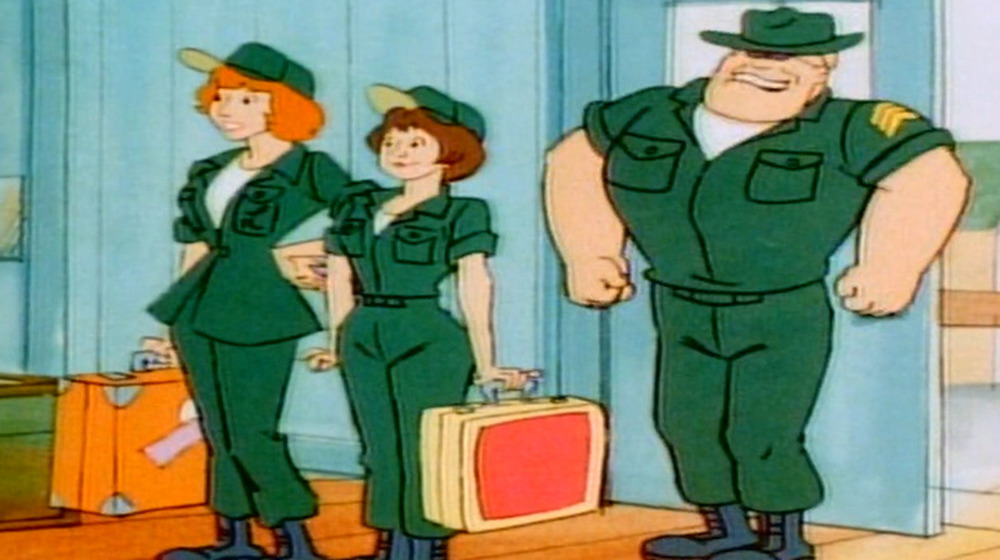The Untold Truth Of Laverne & Shirley
Give them any chance, they'd take it, give them any rule, they'd break it — Laverne and Shirley were going to make their dreams come true, their way.
Laverne & Shirley – starring Penny Marshall and Cindy Williams as the street-smart, self-sufficient, Shotz Brewery bottle-cappers in early 1960s Milwaukee — ran on ABC from 1976 to 1983, and it was one of the most popular sitcoms of its era ... or any era, for that matter. Millions tuned in each week to watch Laverne and Shirley get themselves into jams, go on bad dates, strive for a better life outside of their tiny apartment, and get embroiled in mishaps. And that's to say nothing of their friends and associates Carmine "The Big Ragu" Ragusa, Big Rosie, and fan-favorites Lenny and Squiggy — wannabe bad boys but really total dweebs.
A spinoff of Happy Days — another Garry Marshall-created, retro-flavored megahit — Laverne & Shirley was a television institution. And if you want to know more about this beloved sitcom, here are some behind-the-scenes stories about the creation, production, and impact of Laverne & Shirley.
Laverne and Shirley originated as tough ladies on Happy Days
By its third season in 1975, Happy Days was a smash hit, a top 10 show and cultural phenomenon. That was thanks partly to former child star Ron Howard as amiable 1950s teenager Richie Cunningham but mostly because of Henry Winkler as Arthur "Fonzie" Fonzarelli, the coolest guy in Milwaukee. An appearance on the heavily viewed show could be career-changing for an actor, and that's exactly what happened to Penny Marshall and Cindy Williams.
On November 11, 1975, the episode "A Date with Fonzie" aired. As for the plot, Richie is having a hard time landing a date, so Fonzie sets them up for a double date. Richie winds up way out of his depth because the women Fonzie selects for them are a lot older, more aggressive, and more experienced than the high school students Richie usually dates. As Penny Marshall told the Television Academy Foundation, Happy Days producer Garry Marshall (her brother) described the duo as "fast girls, girls who 'put out.'" The two performers (writing partners at the time) signed on for the one episode, and that was it ... until after it aired and TV executives thought Laverne (Marshall) and Shirley (Williams) could carry their own series.
Less than three months after that Happy Days episode, Laverne & Shirley debuted. For the 1975-76 season, it ranked as the #2 show on TV, outdrawing even its predecessor series.
Laverne & Shirley is a semi-remake
Garry Marshall is the undisputed king of 1970s sitcoms. Prior to creating Laverne & Shirley, Happy Days, and Mork and Mindy, he had his first big hit developing and writing for the television adaptation of Neil Simon's comic stage play The Odd Couple. That series went off the air in 1975, and Laverne & Shirley was scheduled to hit ABC as a midseason replacement in early 1976. To get it up and running in a relatively quick manner, Marshall (and production studio Paramount) had to act quickly and recycle where possible. According to Maclean's, the Laverne & Shirley main apartment set is simply the revamped apartment set of Oscar and Felix from The Odd Couple.
Scripts for Laverne & Shirley also leaned heavily on preexisting sitcoms. For example, Hey, Landlord lasted two short seasons in 1966 and 1967, and it was a show about a guy who moves to New York, inherits an apartment, and shares it with a comedian. Marshall reused many elements of that forgotten, unpopular sitcom in episodes of Laverne & Shirley.
Lenny and Squiggy came before Laverne and Shirley
Laverne & Shirley ran on the laughs generated by two comedy duos — Laverne and Shirley but also Lenny and Squiggy. Portrayed, respectively, by Michael McKean and David L. Lander, Lenny and Squiggy dressed like "greasers" — tough guy hoodlums like you'd find in Grease or The Outsiders. But looks can be deceiving. They were really a couple of truck drivers who worked at Shotz Brewery with Laverne and Shirley (and who wouldn't leave them alone) and were, in actuality, a couple of creepy loser weirdos with strange voices.
Believe it or not, Lenny and Squiggy greatly predate Laverne & Shirley. According to Delaware Liberal, McKean and Lander met as drama students at Carnegie Mellon University in the mid-1960s and developed the characters — originally named Lenny and Ant'ny — while members of the comedy group the Credibility Gap. Actor-director Rob Reiner was a big fan of the characters, and he asked McKean and Lander to perform them at a party that was attended by his wife, Penny Marshall, just before Laverne & Shirley entered production. McKean and Lander landed jobs on the show as writing consultants, and their first order of business was to write themselves into the pilot episode, although producers asked them to rename Ant'ny, and thus Lander's character became Squiggy.
The dorky, confident pair became so popular that McKean and Lander recorded a 1979 album while in character as Lenny and the Squigtones.
Cindy Williams was only barely cast as Shirley
Penny Marshall and Cindy Williams arrived at their respective roles of Laverne and Shirley in different ways. Marshall's brother, Garry Marshall, created the series, and the two had worked together earlier in the '70s on the sitcom The Odd Couple. Williams' route to the show was more circuitous.
According to Penny Marshall in Live from New York: The Uncensored History of Saturday Night Live, Williams was in the running for the role early on, as she'd be reprising a character she originated on Happy Days, but the actress wanted to keep pursuing movie roles. After all, Williams had broken out in George Lucas's American Graffiti and Francis Ford Coppola's The Conversation. Laverne & Shirley producers auditioned a number of actresses in her absence, but Penny Marshall was left underwhelmed, taking it upon herself to try and recruit Saturday Night Live cast member Gilda Radner. "I needed someone strong," Marshall said. However, Radner "had a loyalty to" SNL producer Lorne Michaels, plus that show had only just started airing.
A young actor named Liberty Williams, who'd appeared on episodes of '70s TV shows like Chico and the Man and The Mary Tyler Moore Show, just about had the part of Shirley locked up. Producers called her in for a screen test (and promo photos), only for Cindy Williams to decide she wanted the role after all.
The real reason why Laverne's clothes are adorned with an "L"
One of the most unique stylistic choices on Laverne & Shirley was a fashion choice on the part of the character of Laverne. Seemingly every outfit she wore over the course of the series came adorned with a large, script "L" near the shoulder and neckline. That "L" stands for "Laverne," of course, and its constant presence implies that Laverne makes her own clothes or alters store-bought ones to carry her personalized and identifying touch.
However, Laverne actually wears an "L" all the time due to practical concerns, for the benefit of the audience. "At the beginning of any TV series, you have to repeat who you are, where you're from, and what you do for a living so viewers will get to know you," Laverne herself, Penny Marshall, wrote in her memoir My Mother Was Nuts. But she found that having to repeat identifying information was "boring," and it was just as annoying to hear costar Cindy Williams "say 'Laverne' all the time." Marshall's suggestion, adopted by producers, was to put an "L" on her clothes to instantly let the audience know which character she was. It didn't work. "I was wrong. We still had to say those lines," Marshall wrote.
Laverne & Shirley made Cyndi Grecco's dreams come true
There are many connections between Happy Days and Laverne & Shirley. Garry Marshall created both shows, the latter is a spinoff of the former, and songwriting duo Charles Fox and Norman Gimbel wrote the memorable and catchy theme songs for each series. However, the Laverne & Shirley opening music could've sounded a lot different had the composers not ventured out to a California amusement park to do something nice for a Happy Days cast member.
Pop singer Cyndi Grecco was discovered singing in a pizza parlor and landed a manager, who booked her for a months-long gig. "I went on to Magic Mountain to do an all-summer thing," Grecco told Dick Clark on American Bandstand. "Charlie and Norman came down there to see a friend of mine, Anson Williams," she added, referring to the actor and singer who played Potsie on Happy Days. "And they saw me, and they liked me, they wanted to know what I was doing."
Grecco then mentioned she'd like to record an album at some point, and Fox and Gimbel promised to write something for her. Eventually, they did, and it was the Laverne & Shirley theme song. An extended version of the number, titled "Making Our Dreams Come True," was released as a single and made it to #25 on the Billboard pop chart, Grecco's one and only hit.
Schlemiel? Schlimazel? Hasenpfeffer Incorporated!
Even before Cynthia Grecco's bombastic Laverne & Shirley theme song kicks in, the sitcom's opening sequence gets viewers' attention with a musically underscored, spoken word introduction. On a Milwaukee street at night, Laverne and Shirley march and recite in unison what sounds like a nonsensical, schoolyard chant: "One, two, three, four, five, six, seven, eight, schlemiel, schlimazel, Hasenpfeffer Incorporated!" "Schlemiel," "schlimazel," and "Hasenpfeffer" weren't commonly used words in the American lexicon in the 1970s (or today), so what do they mean? In the context of Laverne & Shirley, almost nothing.
In an interview with the Television Academy Foundation, Williams said that the rest of the credits sequence had already been shot, and creator Garry Marshall needed a bit more footage. He asked Penny Marshall, his sister, about a nonsense song-and-dance routine she used to do while walking to school as a kid decades earlier, and she went through the "schlemiel, schlimazel" spiel. "I don't know what it means," Penny Marshall said, but Garry Marshall told her to teach it to Williams. They had very little time to learn it and only had time to shoot it twice, which Williams said she had a hard time figuring out because of her dyslexia.
So what does it mean? "A schlemiel is someone who falls from a building," Williams explained, "and a schlimazel is the person they land on." Hasenpfeffer is a German stew made of rabbit.
Was Laverne & Shirley's soft reboot a mistake?
There are two ways an aging sitcom can reinvent itself. First, it can generate new storylines and fresh starts for characters. Second, it can change its setting and jump a few years into the future. Laverne & Shirley did both.
At the beginning of the show's sixth season in 1980, side characters Frank and Edna have moved out of Milwaukee in favor of sunny Burbank, California, and after their jobs at the Shotz Brewery are eliminated by automation, Laverne and Shirley head west, as do Carmine, Lenny, and Squiggy. Frank and Edna manage a barbecue joint, Carmine tries to make it as an actor, Lenny and Squiggy open a talent agency, and Laverne and Shirley find jobs as department store gift-wrappers. The gang also mysteriously moved ahead in time by about five years, as the Burbank episodes weren't set in the early '60s like the rest of the show but the late '60s, as evidenced by a Beatles poster on Laverne and Shirley's apartment wall.
The transition was awkward, and it didn't sit well with star Penny Marshall. "I thought the whole thing was a mistake," she wrote in My Mother Was Nuts, arguing that superficial, moneyed Los Angeles "didn't make sense" for the working-class, no-nonsense characters. "They were regular folks. I thought they should go to New York, where they would face new struggles," Marshall wrote, adding that her opinion couldn't persuade producers and executives.
When Shirley left Laverne
Laverne & Shirley successfully weathered big changes and remained a highly rated show in its sixth and seventh seasons. Viewership would slip in season eight, however, likely owing to the sudden loss of a fundamental element. Laverne & Shirley was built on the interplay between its two title characters — which disappeared when Cindy Williams left the series in 1982.
According to Marley Brant's Happier Days: Paramount's Classic Television Sitcoms, 1974-1984, Williams learned she was pregnant, and she claimed that producers would work it into the show but then reneged on the promise, along with guarantees that she'd be paid for episodes she wouldn't appear in. Creator and producer Garry Marshall had also reportedly worked up a plan for Williams to tape as many episodes as possible before her pregnancy became undeniably visible. When it became evident that none of those things were going to happen for Williams, she walked off the set in August 1982 and filed a $20 million lawsuit against producers, which was ultimately settled out of court. She never appeared on Laverne & Shirley again.
It probably also didn't help that one-half of the show's other essential duo disappeared for half the season. Michael McKean, the Lenny of Lenny and Squiggy, departed to film This is Spinal Tap. At any rate, the actor-depleted 1982-83 season of Laverne & Shirley would finish in the Nielsen Top 30, but ABC decided to cancel the long-running sitcom anyway.
Why Laverne drinks Pepsi and milk
Certain characters in the annals of television are associated with particular foods and drinks. Sesame Street's Cookie Monster loves cookies, the Doctor on Doctor Who had an affinity for jelly babies, and Laverne on Laverne & Shirley often guzzled a mixture of milk and Pepsi. It probably tasted something like a Coke float, only it was explicitly made with Pepsi and not Coca-Cola and not as sweet.
It's a trait of the character that Laverne & Shirley creator Garry Marshall pulled from real life, and the childhood of the actor who plays Laverne — Penny Marshall, his sister. "I actually drank that as a kid," the performer wrote in her memoir, My Mother Was Nuts. "At kosher camp," she recalled from childhood, "they couldn't drink milk with meat so they had Pepsi." Marshall wanted to be like the adults and wanted to drink Pepsi with her meals at home, as well. However, as she put it, "My mother made me drink milk first." Only then could she have a serving of the less-healthy, sugary soda. "Sometimes she didn't rinse out the glass. Sometimes it wasn't even empty. Eventually it became half and half." The Marshall siblings included the slightly stomach-churning concoction in Laverne & Shirley knowing that "it would get a reaction."
The many spinoffs of Laverne & Shirley
Television networks, particularly in the '70s and '80s, sought to build franchises out of successful series by spinning off characters into their own shows. Itself a spinoff of Happy Days (like Mork and Mindy and Joanie Loves Chachi), Laverne & Shirley also led to more programming for ABC. During the first season of Laverne & Shirley, breakout characters Lenny and Squiggy proved so popular that ABC president Fred Silverman asked show creator Garry Marshall to come up with a showcase show for the weird duo. Marshall dutifully came up with the self-explanatory Lenny and Squiggy in the Army. Producer Paramount Television liked the notion, but ABC didn't like the pilot episode and dropped the idea.
Five years later, ABC revisited the idea of Laverne & Shirley in the military in the form of a Saturday morning cartoon. The sitcom was popular with children, and in 1981, Laverne & Shirley in the Army debuted, featuring the title characters (along with Lenny and Squiggy) signing up for and getting drafted into the U.S. Army in advance of a war. The animated spinoff lasted just 19 episodes.
